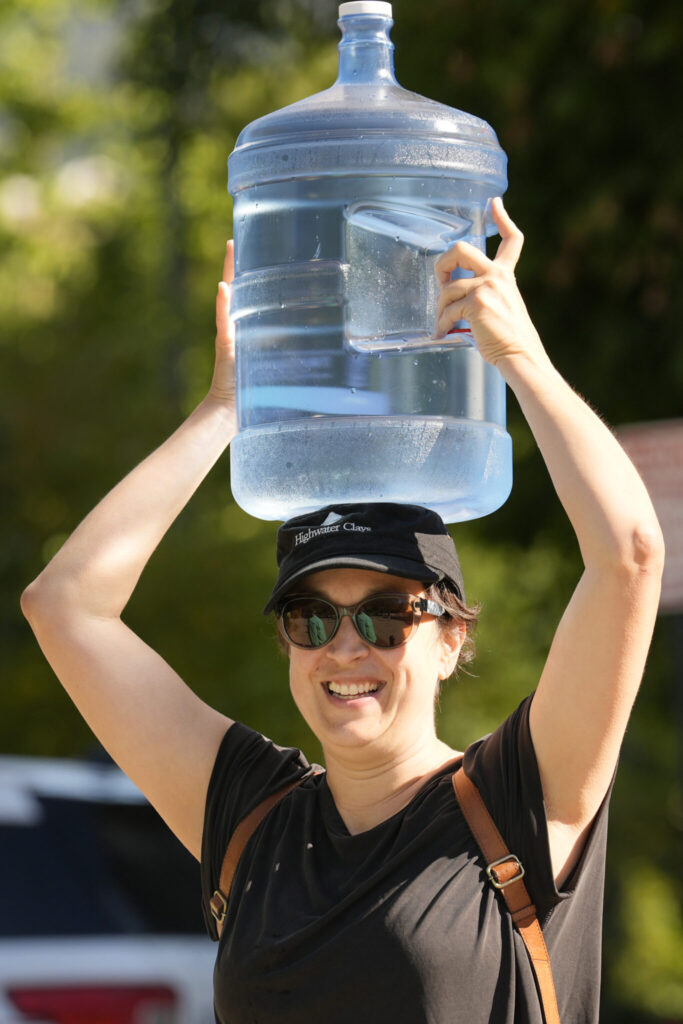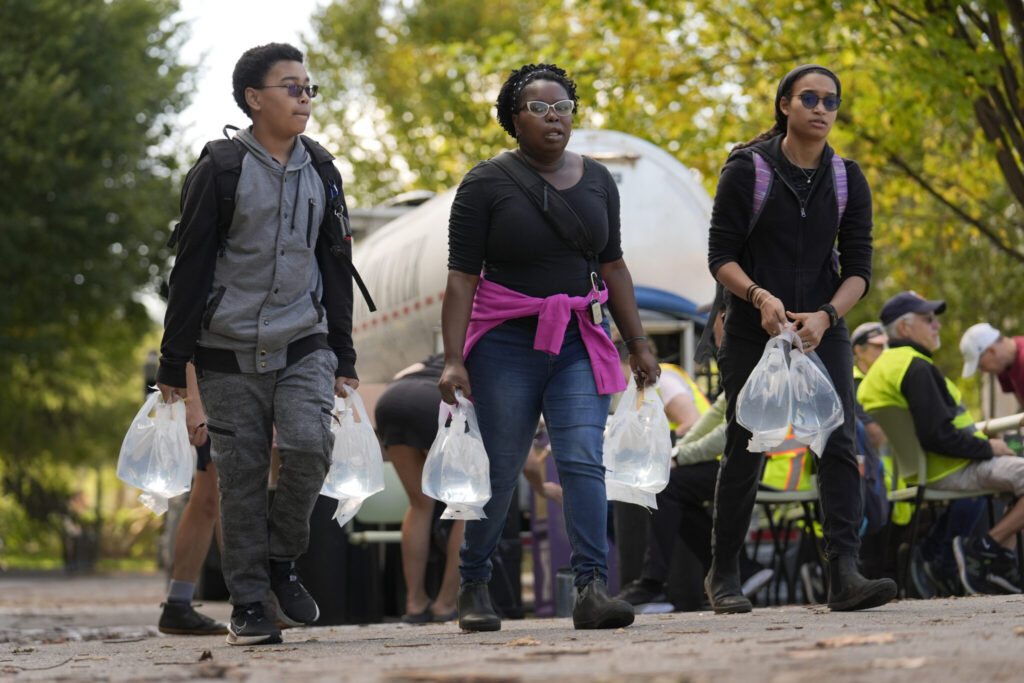Hurricane Helene, Asheville water crisis, North Carolina water shortages, Helene aftermath, U.S. storm damage 2024/ Newslooks/ ASHEVILLE/ N.C./ J. Mansour/ Morning Edition/ Nearly a week after Hurricane Helene devastated western North Carolina, thousands remain without access to clean water, struggling to meet basic needs. The storm severely damaged Asheville’s water system, and officials estimate that repairs could take weeks. Residents have turned to makeshift solutions while federal assistance arrives, but the water crisis remains a pressing concern for the region.

A Week After Helene, North Carolina Residents Still Struggle Without Water Quick Looks
- Severe water shortages: Flooding from Hurricane Helene destroyed Asheville’s water infrastructure, leaving thousands without drinking water.
- Federal assistance: Millions of gallons of water are being shipped in, but repairs to the system could take weeks.
- Public health risk: Lack of clean water has caused widespread health concerns, with many residents resorting to makeshift solutions for hygiene and sanitation.
- Climate impact: Experts urge stronger infrastructure investment as storms become more severe due to climate change.
Thousands in NC Struggle Without Water a Week After Hurricane Helene
Deep Look
Nearly a week after Hurricane Helene tore through western North Carolina, residents of Asheville and surrounding areas are still facing severe water shortages, compounding the hardships brought by the devastating storm. Flooding from Helene wreaked havoc on the city’s water system, destroying critical infrastructure and leaving tens of thousands of people scrambling for drinking water.
In downtown Asheville, a shiny stainless steel tanker truck has become a lifeline for residents. People line up with whatever containers they can find—milk jugs, buckets, 5-gallon tanks—hoping to fill them with drinking water. For Anna Ramsey and her two children, the trip to collect water has become routine. “We have no water. We have no power. But I think it’s also been humbling,” Ramsey said, reflecting on the storm’s aftermath.
The destruction left by Helene is widespread, and the water crisis it triggered is far from over. Floodwaters ripped through Asheville’s water system, scouring out pipelines from one of its main reservoirs. Another reservoir remains inaccessible until a damaged road leading to it is repaired. Meanwhile, limited water flow has been restored to some southern neighborhoods, but the full recovery of the system is expected to take weeks.
“Running water would be incredible,” said Sue Riles, a resident of Asheville who, like many others, has been living without basic amenities since the storm hit. After days without running water, residents are longing for more than just sponge baths. “I would love a shower,” Riles added.
Widespread Damage and Public Health Concerns
As Hurricane Helene swept through the Southeast, it left behind a trail of destruction, including power outages visible from space and tens of trillions of gallons of rain that flooded towns and cities. More than 200 people were killed, making Helene the deadliest hurricane in the U.S. since Hurricane Katrina in 2005. Hundreds remain unaccounted for as search crews navigate knee-deep debris to locate missing residents.
The storm’s damage to water infrastructure across the region is particularly dire. An estimated 136,000 people in the Southeast are served by nonoperational water systems, and more than 1.8 million are living under boil water advisories, according to the Environmental Protection Agency (EPA). In Asheville, the destruction of pipelines and water treatment facilities means residents have no clean water for drinking, cooking, or sanitation.
Drew Reisinger, Buncombe County’s register of deeds, voiced concerns about the public health risks mounting in the absence of running water. “One thing no one is talking about is the amount of poop that exists in every toilet in Asheville,” Reisinger said, highlighting the unsanitary conditions many are living in. With limited water even for flushing toilets, residents are being advised to collect non-drinkable water from a local swimming pool to use for household needs.
Without clean water, the risk of illness grows each day. Residents who do have running water are being urged to boil it, but that, too, has its challenges. According to Natalie Exum, an assistant professor at Johns Hopkins Bloomberg School of Public Health, boiling water is time-consuming and easy to do incorrectly. “Every day that goes by, you could be exposed to a pathogen,” Exum warned.
Recovery Efforts and Challenges
Efforts to restore water services and repair infrastructure are ongoing. Federal officials have delivered millions of gallons of water to affected areas, while more than 8,000 utility workers are working to restore power across North Carolina. By Thursday, 62% of homes and businesses had power again, but in some areas, cellphone service remains down, leaving many disconnected.
Repairing the damage to water systems is a massive undertaking. Floodwaters not only damaged roads but also buried pipelines under twisted debris, making it difficult for repair crews to assess the full extent of the damage. “Pretty much anytime you see a major road damaged, there’s a very good chance that there’s a pipe in there that’s also gotten damaged,” explained Mark White, an engineer specializing in drinking water systems.
Despite the immense challenges, recovery is progressing slowly. Travis Edwards, an Asheville resident, managed to fill containers with water immediately after the storm but quickly saw the flow weaken and stop. His family resorted to using hand sanitizer and rationing the little water they had. “We didn’t realize how dehydrated we were getting,” Edwards said.
Preparing for Future Storms
Hurricane Helene has exposed the vulnerabilities in the region’s infrastructure, prompting calls for greater investment to withstand future storms. Craig Colten, a former professor specializing in resilience to extreme weather, emphasized the need for stronger infrastructure to handle such disasters. “There’s often a ‘blind faith’ assumption that drinking water won’t fail,” Colten said, adding that the damage from Helene should serve as a wake-up call to politicians.
As climate change intensifies, storms like Helene are expected to become more frequent and more severe. Erik Olson, an expert at the Natural Resources Defense Council, urged state and federal governments to take action. “We need to start looking at how we’re going to prepare for these extreme weather events that are going to be occurring and recurring every single year,” Olson said.
For many residents, the return to normalcy remains a distant goal. Edwards, who has developed a system to recycle water for household use, expressed relief that water distribution sites have eased some of the burden. “To not feel guilty about using more than a cup of water to, like, wash yourself … I’m really, really grateful,” he said.







